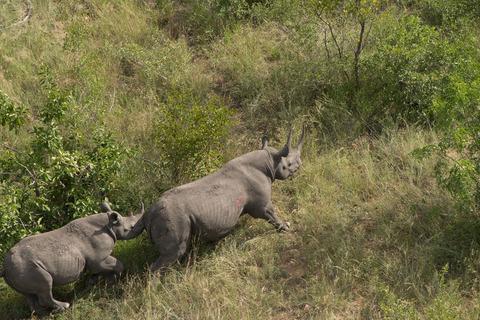当前位置:
X-MOL 学术
›
Anim. Conserv.
›
论文详情
Our official English website, www.x-mol.net, welcomes your feedback! (Note: you will need to create a separate account there.)
Poaching creates ecological traps within an iconic protected area
Animal Conservation ( IF 3.4 ) Pub Date : 2019-08-26 , DOI: 10.1111/acv.12532 N. Roex 1, 2 , C. Dreyer 3 , S. M. Ferreira 1
Animal Conservation ( IF 3.4 ) Pub Date : 2019-08-26 , DOI: 10.1111/acv.12532 N. Roex 1, 2 , C. Dreyer 3 , S. M. Ferreira 1
Affiliation

|
Ecological traps occur when areas preferentially selected by a species harbour an unknown increased mortality risk or reduced fitness for the individuals utilizing them. If animals continue to utilize these habitats, rapid declines may result that threaten the persistence of the population. Both black and white rhinoceroses are plagued by severe, targeted rhino poaching in South Africa that may have population and species‐level consequences in the long term. Poaching can rapidly increase mortality and may create habitats that function as ecological traps for protected populations. We used spatially explicit data of live rhino and poached rhino carcasses in the Kruger National Park, South Africa, to define high‐ and low‐risk states for both black and white rhino species. The proportion of area functioning as ecological trap was similar for both species (black: 37.73%, white: 35.51%), while the proportion of safe harbour was considerably lower for black rhino (black rhino: 32.01%, white rhino: 44.74%). Species‐specific risk areas were condensed into management categories that reflect the actions most likely to be effective for overall rhino protection in those areas. ‘Threat’ area, representing ecological traps for both species, comprised 32.48% of southern Kruger; this represents the highest priority for anti‐poaching interventions. A further 31.03% was identified as ‘haven’, representing safe harbours for both species, which may benefit most from continued rhino monitoring and surveillance. Using these categories, authorities can prioritize the distribution of limited resources and tailor anti‐poaching and biological management actions according to the needs of each area for the concurrent protection of both rhino species. This work illustrates how the conservation of multiple species or taxa within a system can be simultaneously prioritized in vast areas where resources and/or capacity may be insufficient to undertake species‐specific approaches.
中文翻译:

偷猎在标志性保护区内制造生态陷阱
当物种优先选择的区域隐匿着未知的增加的死亡风险或降低了利用它们的个体的适应性时,就会发生生态陷阱。如果动物继续利用这些栖息地,则可能导致动物数量迅速减少,从而威胁到种群的持久性。南非的黑犀牛和白犀牛都受到严重的针对性犀牛偷猎的困扰,从长远来看,这可能会对种群和物种造成严重影响。偷猎会迅速增加死亡率,并可能创造出栖息地,成为保护种群的生态陷阱。我们使用了南非克鲁格国家公园中的活犀牛和水煮犀牛尸体的空间显式数据,为黑白犀牛物种定义了高风险和低风险状态。两种物种作为生态陷阱的区域比例相似(黑色:37.73%,白色:35.51%),而黑犀牛的安全港比例则低得多(黑犀牛:32.01%,白犀牛:44.74%) 。特定于物种的风险区域被归为管理类别,这些类别反映了最有可能对这些区域的整体犀牛保护有效的行动。代表两种物种生态陷阱的“威胁”区域占克鲁格南部的32.48%;这是反偷猎干预措施的最高优先事项。另有31.03%被确定为“避风港”,代表着这两个物种的安全港,它们可能会由于持续的犀牛监测和监视而受益最多。使用这些类别,当局可以根据每个地区同时保护两种犀牛物种的需要,优先分配有限的资源,并制定反偷猎和生物管理措施。这项工作说明了如何在资源和/或能力可能不足以采取特定物种方法的广阔地区中,同时优先考虑系统中多种物种或生物分类的保护。
更新日期:2019-08-26
中文翻译:

偷猎在标志性保护区内制造生态陷阱
当物种优先选择的区域隐匿着未知的增加的死亡风险或降低了利用它们的个体的适应性时,就会发生生态陷阱。如果动物继续利用这些栖息地,则可能导致动物数量迅速减少,从而威胁到种群的持久性。南非的黑犀牛和白犀牛都受到严重的针对性犀牛偷猎的困扰,从长远来看,这可能会对种群和物种造成严重影响。偷猎会迅速增加死亡率,并可能创造出栖息地,成为保护种群的生态陷阱。我们使用了南非克鲁格国家公园中的活犀牛和水煮犀牛尸体的空间显式数据,为黑白犀牛物种定义了高风险和低风险状态。两种物种作为生态陷阱的区域比例相似(黑色:37.73%,白色:35.51%),而黑犀牛的安全港比例则低得多(黑犀牛:32.01%,白犀牛:44.74%) 。特定于物种的风险区域被归为管理类别,这些类别反映了最有可能对这些区域的整体犀牛保护有效的行动。代表两种物种生态陷阱的“威胁”区域占克鲁格南部的32.48%;这是反偷猎干预措施的最高优先事项。另有31.03%被确定为“避风港”,代表着这两个物种的安全港,它们可能会由于持续的犀牛监测和监视而受益最多。使用这些类别,当局可以根据每个地区同时保护两种犀牛物种的需要,优先分配有限的资源,并制定反偷猎和生物管理措施。这项工作说明了如何在资源和/或能力可能不足以采取特定物种方法的广阔地区中,同时优先考虑系统中多种物种或生物分类的保护。



























 京公网安备 11010802027423号
京公网安备 11010802027423号